How to Organize and Process Feedback for B2B SaaS Product [20/100]
Disclaimer: I don’t have experience in mobile development or game development, but I do have expertise in B2B SaaS products, so let’s dig deeper into B2B SaaS product feedback management.
Why organize product feedback?
Product always lives in a context and this context shapes the product. Context is always complex. It includes market, competitors, technologies, team, users, customers, founders vision, zeitgeist, and luck. We build products for people. People give us feedback. Feedback shapes our product. It’s as simple as that. However, feedback organization and utilization are not so simple.
Everything can go wrong. You may ignore important feedback and pay attention to the feedback that proves your vision. You may react to recent feedback and ignore frequent feedback. You may pay more attention to competitors and less attention to your product users. You may mix feedback from paid customers, free customers, target persona and edge cases and don’t see the difference. However, this segmentation is important to focus on paid target customers and know their needs.
What feedback sources you need?
There are many product feedback sources, but not all of them are important. Anyway, survived product owner pays attention to all of them.
More important
- 🌶 Interviews (meeting notes). One of the most important feedback channels. Here you talk to a real person, can ask deeper questions, and feel the vibes.
- Chats (Intercom). Chats are a great source of quick focused requests and problems. Do you have this feature? Or how can I do that? The problem here it’s not always clear who is asking and what is the real need behind the request.
- Community (Discourse, Slack, etc). Deep discussions are happening here and you can easily collect cool insights from these discussions.
- Emails. In SMB market this is less frequent, but in enterprise segments email communication is still quite a thing.
- Help Desk (Zendesk, etc). In a help desk, you mostly get issues and problems, plus some feature requests. In my experience help desk can be easily replaced by Live chats if the volume is sane. For super-popular products live chats will not survive the load.
Less important
- Reviews (G2 crowd, etc). Somehow most reviews are positive, but to get something interesting you have to focus on negative things.
- Social media (Twitter, etc). Feedback from random people is hard to categorize.
- Competitors (Community, releases, etc.). You should be aware of major competitors’ strengths and weaknesses, but over-focusing on competitors will lead to copy-cat products and features. Waste of human resources. Waste of life.

Most product managers use their brains as single storage of all feedback. The brain is good to generalize and build intuitive feelings about various problems in the product, but at the same time brain is full of biases and tends to forget things.
It’s better to have a tool that aggregates all feedback into a single database and connects all feedback into real work (features, stories).
How to organize product feedback?
Let’s try to focus on feedback properties first.
Feedback importance
Feedback is not equal. A tweet “I need export to markdown” from a random person does not equal an “I need export to markdown” phrase from your target paid customer on the call.
I think two dimensions are enough to set feedback importance:
- User involvement. Feedback from paid customers is more important.
- User segmentation. Feedback from your target segments is more important.
For example, you build an Intercom-like system and your target case is “customer support in SaaS products”. So you will de-prioritize feedback from users who uses your solution on e-commerce websites.
When someone pays you money, you should listen better. They see enough value in your product to pay you, so most likely their problems are more important. You want to make them happy and increase word-of-mouth promotion probability. However, if you have feedback from the target segment, you should listen very carefully as well, since you want to make them happy and understand what they miss to have enough value to purchase.
Here is the possible weights table for every feedback item based on users involvement and user segmentation”
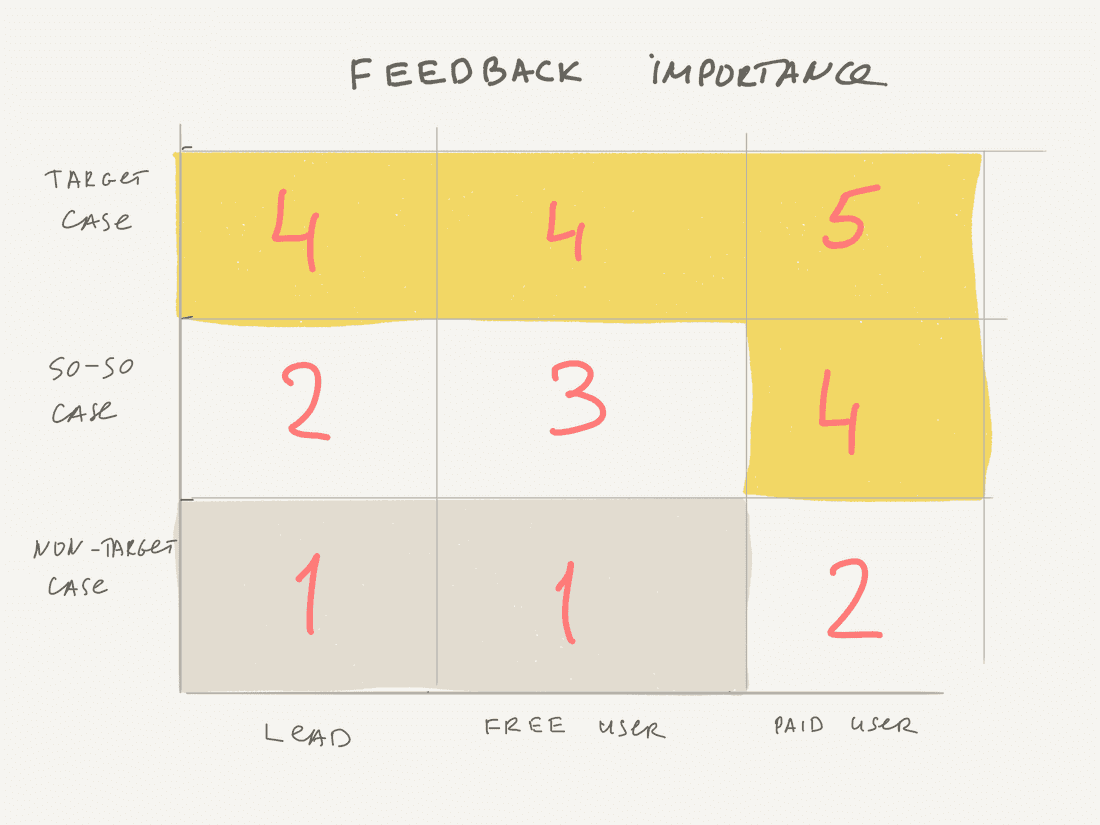
Product feedback volume
Feedback volume can beat feedback importance in some cases. Imagine you have hundreds of requests from e-commerce websites for your chat solution, but you never target this segment. Congratulations, you just found the new market niche! It’s a hard strategic decision to move into it, but at least you know that you have the opportunity.
When you identified several potential market segments, it’s good to link feedback to the segments to understand what segment is more promising.
Feedback score
To calculate feedback score we have to use feedback volume and feedback importance. The formula can be as simple as a sum of weights of all requests:
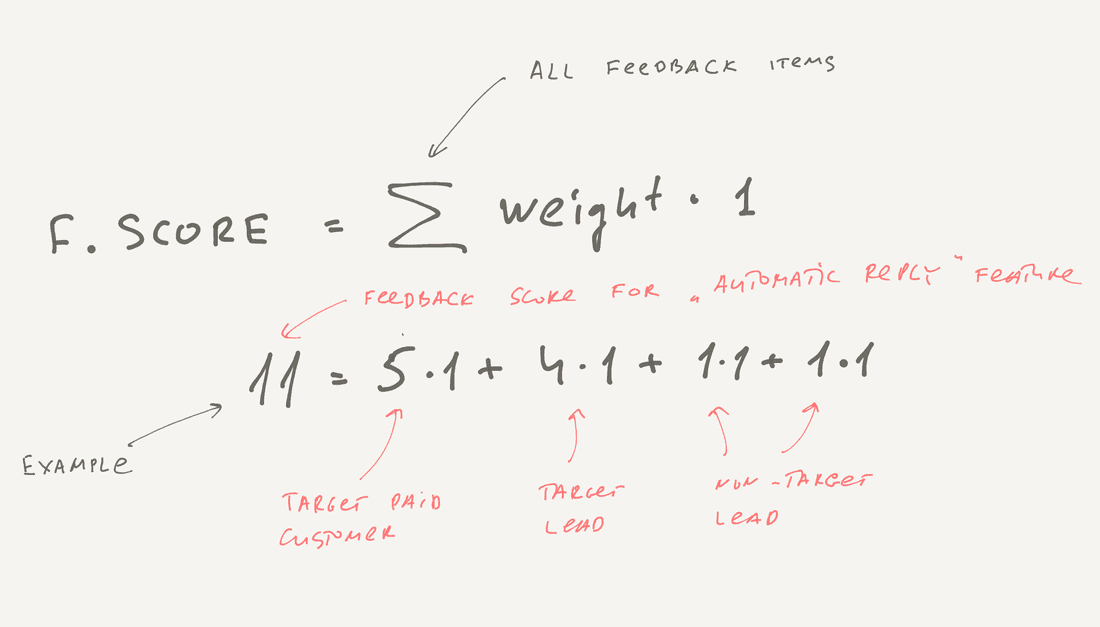
Now we can have all our feedback requests ranked by feedback score and see what requests/features/ideas are the most important.
Product feedback hierarchy
How to categorize feedback? It is not a trivial task in fact. Should you link it to insight, to a task, to a user story, to a feature, to some general category? It depends. My advice is to split your product into a hierarchy and link feedback to the lowest possible leaf node. An extreme example is when you know nothing about the product, you can attach the feedback to a product itself only, but if you know everything about the product you may know that this feedback belongs to a very specific feature.
Here is an example of a possible product hierarchy. We split our product into high-level Product Areas (Search, Notifications, Integrations, etc). Then we have Insights and Ideas — this is something that we might implement in the future, but we are not sure so far or don’t know how exactly. Then we have Features, Stories, and Bugs — quite usual product functionality entities that many product managers use.
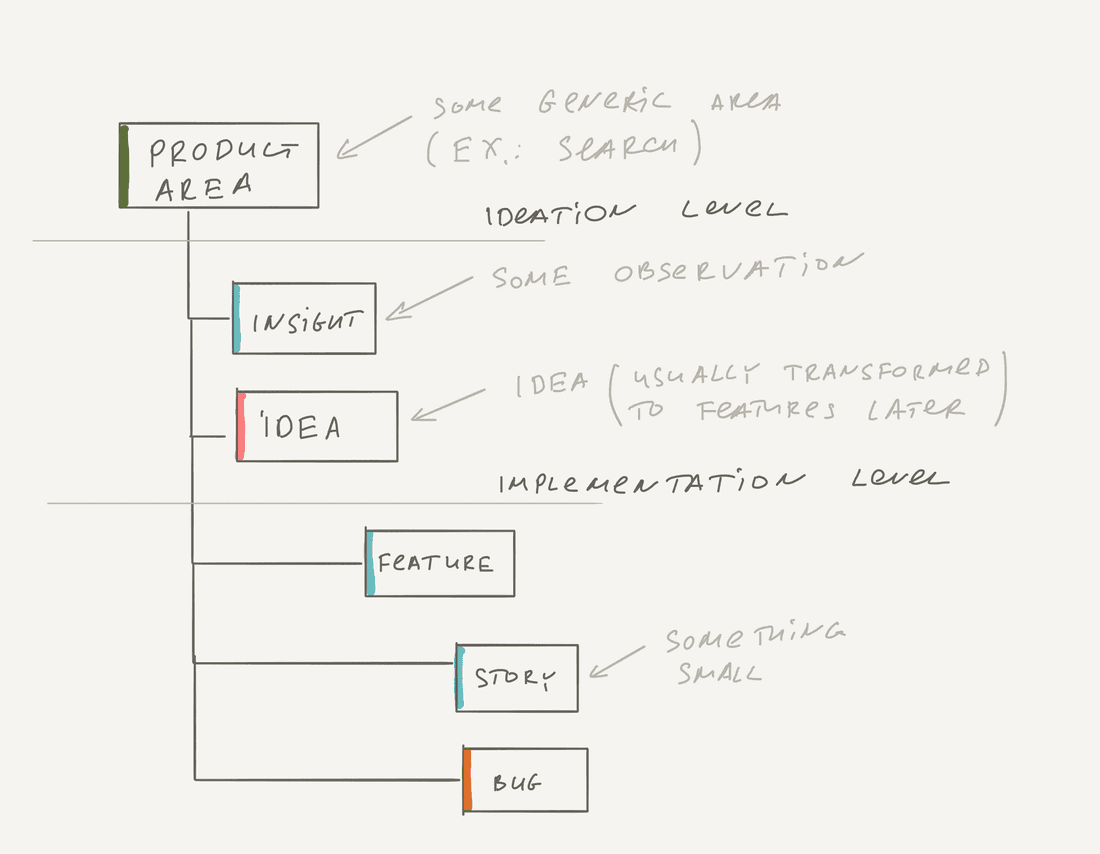
Let’s say you got feedback “I want to receive a reply to my email if an agent did not respond in 1 minute”. If you have the Feature “Reply email notification”, then you can link this feedback to this feature. If you don’t have anything specific, then you should link this feedback to “Notifications” Product Area.
With time “Notifications” Product Area may accumulate dozens of feedback items, so you should review product areas periodically, create new features, ideas and stories and move feedback items to the lower levels. Here is how we do it in Fibery. This is a tree of our Product Areas with Features, Ideas, Insights, and User Stories. On the right you see a feedback score for every item (note that we use the last 6 months period for this score to ignore old feedback):

You might be curious how feedback looks inside a Feature. Here is the feedback linked to the “Follow an entity and get notifications” Feature:
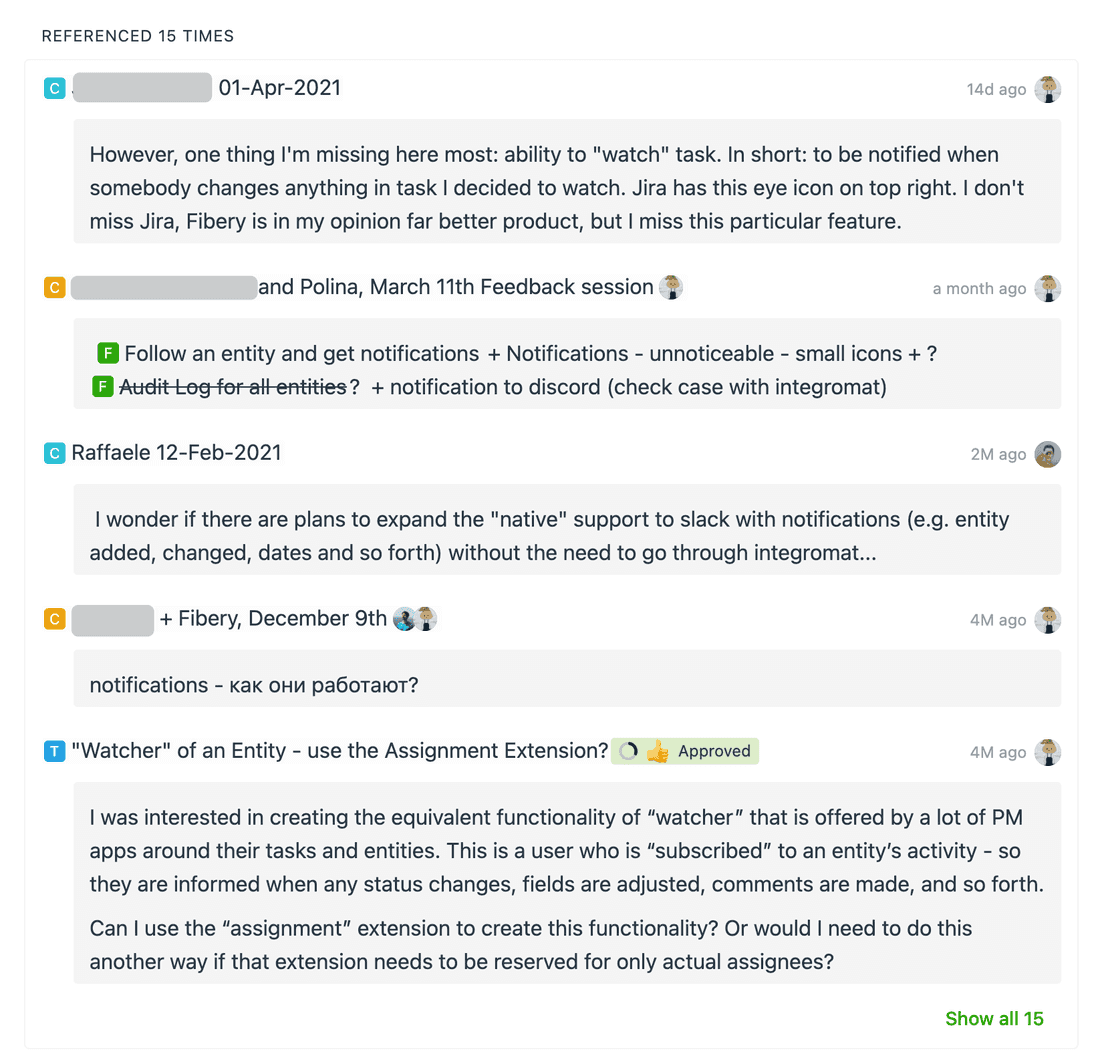
What to do with accumulated product feedback?
OK, so you have all the feedback, now what? Feedback collection by itself has zero value, you have to put it into action.
Prioritize work
I think work prioritization is the hardest problem in product management. By picking the wrong features you can kill the product faster than anything else.
To be honest, I don’t like almost all prioritization frameworks (like RICE, for example). They create a false feeling of confidence. I tend to use four things to make decisions about what to build next:
- Feedback score (input from our users).
- Our current strategic focus (let’s say, we are focusing on “Product Teams in SaaS B2B companies”, so I’ll filter features that make sense for this niche).
- Our vision (you can’t always rely on feedback, otherwise you will always build just a better horse).
- Features network. How this new feature will affect other features? Is there any synergy?
Work prioritization is more an art than a science. Here is the real example of a list of all Features, Ideas, Insights, and Stories sorted by feedback score. It really helps us to know what is the most pressing problems in our product:
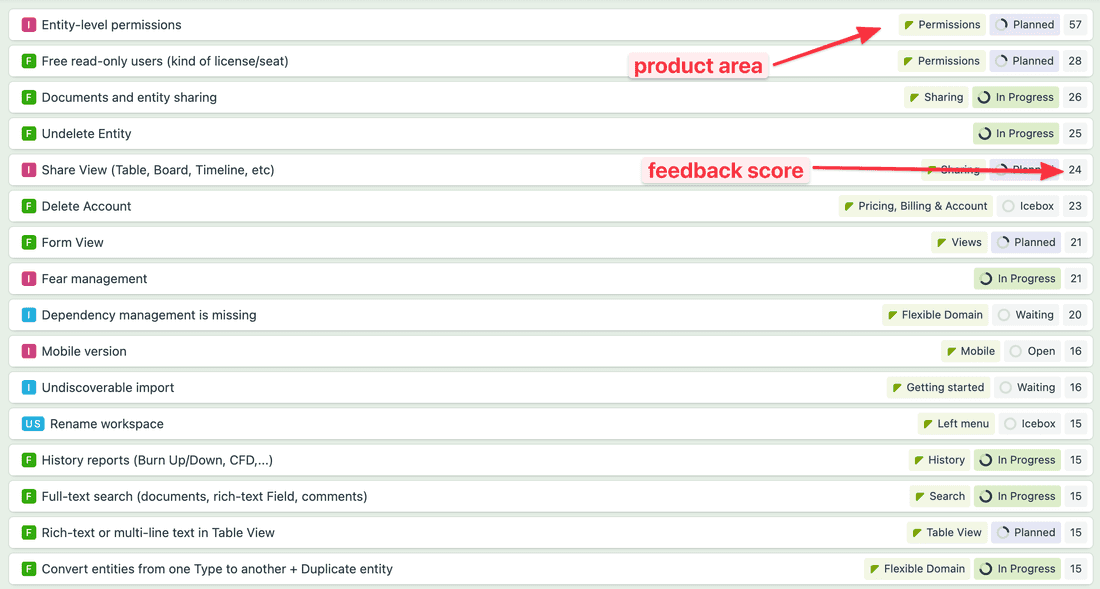
Invent better solutions
When you accumulate feedback for some problem, it almost always helps you to invent a solution. It contains real cases from real users and it helps to understand the problem better. You can also contact these people and ask for more info when required. For example, if you have many requests about “automated replies”, you can contact people and investigate their behavior, what they want to automate, how often they will use this feature, etc.
We have almost 50 feedback items in Automation Product Ares, and some of them are very detailed cases that clearly affect our conceptual solution:
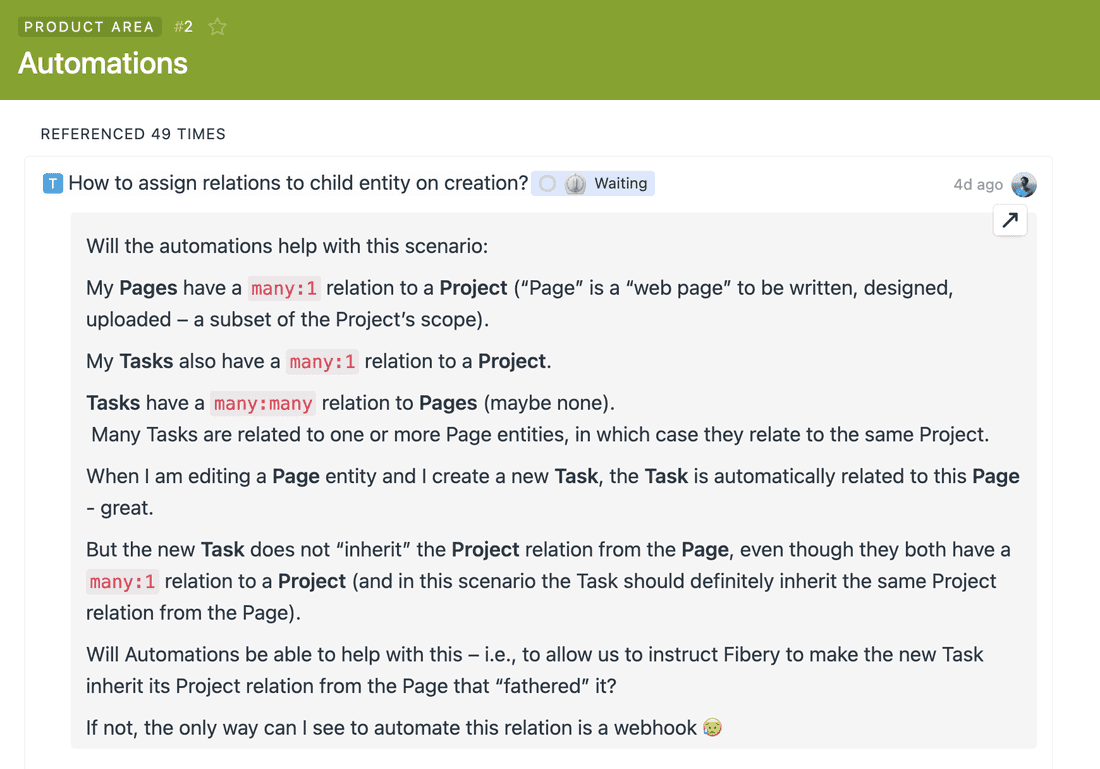
Close feedback loop
Finally, when you implement a feature, you have a chance to notify all requesters about the feature completion. It’s always cool to receive a personalized message and enjoy the feeling that you helped to make the product better.
Is there a tool that can do all that?
Well, yes and no. We use Fibery for product feedback management, it can do pretty much of everything above:
- Fetch feedback from Intercom, Zendesk, Discourse, and call transcripts.
- Connect feedback to Product Areas, Features, Stories with bi-directional links.
- Help with ideation and feedback loop closing.
- Calculate feedback score.
🦐 There are still some missing parts in Fibery though:
- It’s not possible to separate product feedback by segments, so the Feedback Score metric will be generalized and not precise. I still use my intuition to segment features.
- Fibery has no feedback portal to interact with users.
- Feedback re-linking from a product area to a feature might be a tedious manual task…
Feedback is important, don’t waste it.
Psst... Wanna try Fibery? 👀
Infinitely flexible product discovery & development platform.
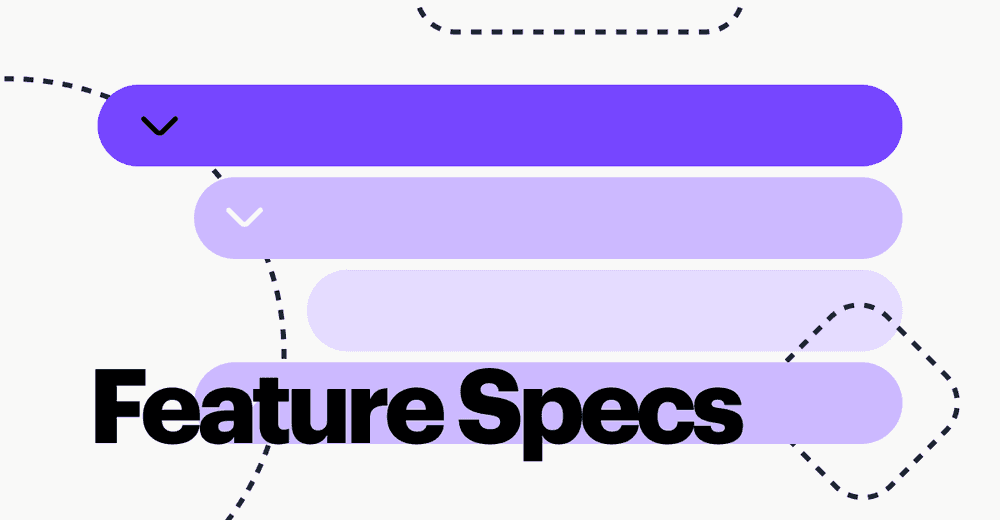

![Be different [23/100]](/blog/static/64355cda924c61c299f2978da5ba6d31/f4829/be-different.jpg)
![5 Biggest Problems in Software Development [22/100]](/blog/static/08512600f4074191672f6e4b07557f7f/d8027/SoftDevProblems.png)